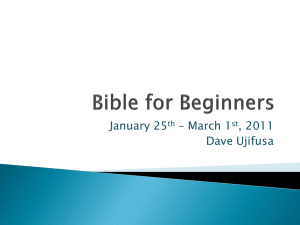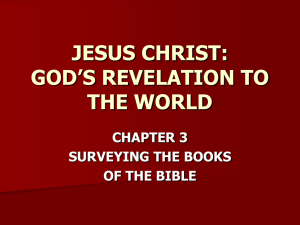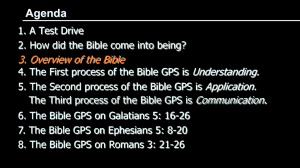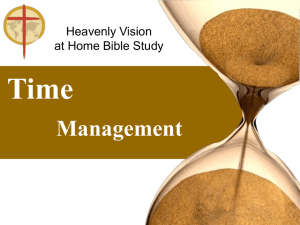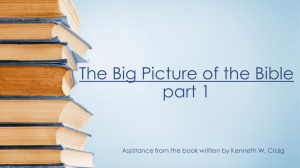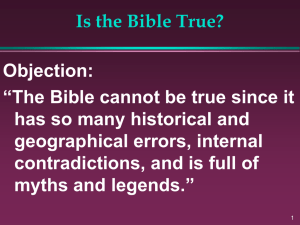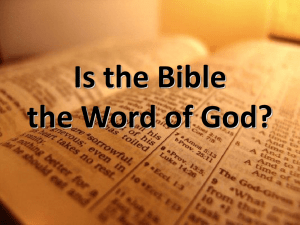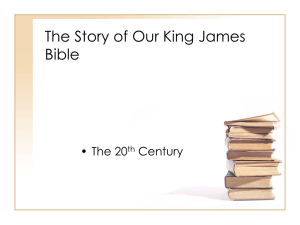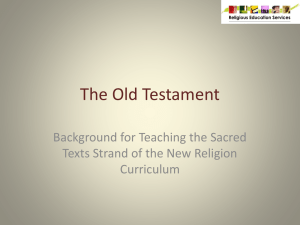Story of Scripture PowerPoint
advertisement
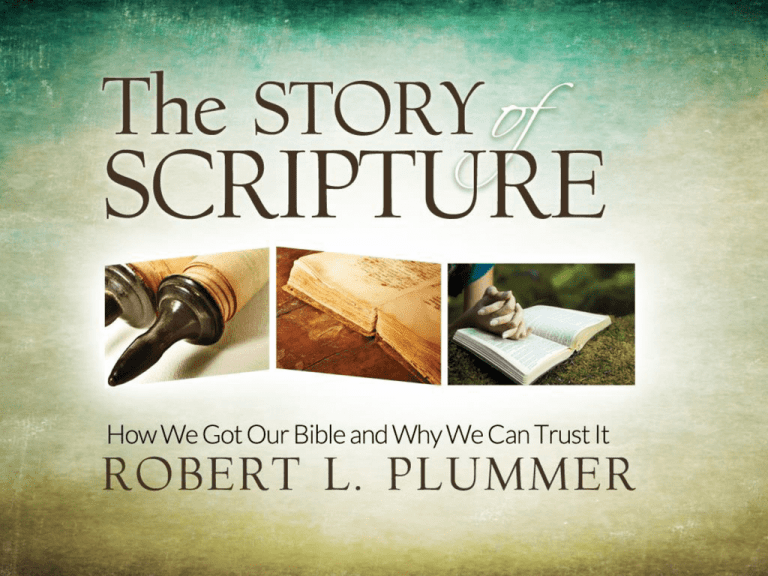
Chapter 1: The Nature and Purpose of the Bible OVERVIEW of the Bible The PURPOSE of the Bible BASIC STORYLINE of the Bible Functions of the Bible • Conviction of sin • Correction and Instruction • Spiritual Fruitfulness • Perseverance • Joy and Delight • Ultimate Authority in Doctrine and Deed C-H-R-O-N-O-L-O-G-Y of the Bible’s Composition Timeline of Biblical Events and Books Adam and Eve (LTA) Noah (LTA) The calling of Abraham 2000 B.C. The exodus 1446 B.C. (Moses authors 1rst books) The monarchy begins 1050 B.C. (God chooses Saul) King David 1010-970 B.C King Solomon 970-930 B.C. The divided kingdom 931 B.C (Israel/Judah divide) The Assyrian exile 722 B.C. (Samaria destroyed) The Babylonian exile 586 B.C. (Jerusalem destroyed) The Persian period 537 B.C. (return of Jews under Cyrus) Timeline of Biblical Events and Books Second Temple finished 515 B.C. Nehemiah/Ezra Mid-400s B.C. Malachi (last OT book) 430 B.C. Intertestamental period 430 B.C.-A.D. 45 Jesus’ birth 7-4 B.C. Jesus’ ministry A.D. 27-30 Jesus’ crucifixion A.D. 30 First NT book(s) written A.D. 45 Revelation written A.D. 90 (last book of NT) Chapter 2: The Organization of the Bible The Basic Division— The Testaments Number and Order of the Old Testament Books THE OLD TESTAMENT 1. LAW 2. HISTORICAL BOOKS 3. WISDOM BOOKS 4. PROPHETICAL BOOKS LAW Genesis Exodus Leviticus Numbers Deuteronomy HISTORICAL BOOKS • Joshua • Judges • Ruth • 1-2 Samuel • 1-2 Kings • 1-2 Chronicles • Ezra • Nehemiah • Esther WISDOM Job Psalms Proverbs Ecclesiastes Song of Solomon (Song of Songs) PROPHETICAL BOOKS Major Prophets Minor Prophets Isaiah Hosea-Malachi Jeremiah (The Twelve) Lamentations Ezekiel Daniel NUMBER AND ORDER OF NEW TESTAMENT BOOKS GOSPELS AND ACTS Mathew Mark Luke John Acts PAULINE LETTERS Romans 1-2 Corinthians Galatians Ephesians Philippians Colossians 1-2 Thessalonians 1-2 Timothy Titus Philemon GENERAL LETTERS AND REVELATION Hebrews James 1-2 Peter 1-3 John Jude Revelation CHAPTER DIVISIONS VERSE DIVISIONS Chapter 3: The Authorship of the Bible Theories of Inspiration The Intuition Theory The Illumination Theory The Dynamic Theory The Dictation Theory The Verbal Plenary Theory DUAL AUTHORSHIP OF SCRIPTURE VARIATION WITHIN DUAL AUTHORSHIP Some Implications of Dual Authorship •The Purpose of the Human Author •Divine Patterns of Foreshadowing •Meaning Exceeding the Conscious Intent of the Human Author? Inspiration & Incarnation Chapter 4: The Authority and Accuracy of the Bible THE VOCABULARY OF INERRANCY • Inerrant / Inerrancy • Infallible / Infallibility • Inspired / Inspiration • Neo-orthodox / Neo-orthodoxy • Trustworthy / True / Authoritative SCRIPTURE’S CLAIMS ABOUT ITSELF • NUMBERS 23:19 • PSALM 12:6 • 2 TIMOTHY 3:16 • 2 PETER 1:21 • JOHN 10:35 • HEBREWS 1:1-2 THE HISTORIC VIEW OF THE CHRISTIAN CHURCH QUALIFICATIONS OF INERRANCY 1. APPLIES ONLY TO AUTOGRAPHS 2. RESPECTS AUTHORIAL INTENT AND LITERARY CONVENTIONS (NOTE: ORDER OF EVENTS IN THE GOSPELS) 3. ALLOWS FOR PARTIAL REPORTING, PARAPHRASING, AND SUMMARIZING QUALIFICATIONS OF INERRANCY… 4. ALLOWS FOR PHENOMENOLOGICAL LANGUAGE 5. ALLOWS FOR THE REPORTING OF SPEECH WITHOUT THE ENDORESEMENT OF THE TRUTHFULNESS OF THAT SPEECH 6. DOES NOT MEAN THAT THE BIBLE GIVES DEFINITIVE OR EXHAUSTIVE INFO ON EVERY TOPIC 7. NOT INVALIDATED BY COLLOQUIAL OR NONSTANDARD GRAMMAR/SPELLING. RECOMMENDATIONS FOR DEALING WITH DIFFICULT TEXTS • • • • • • BE SURE YOU ARE INTERACTING WITH REAL TEXTS APPROACH THE TEXT IN TRUST, NOT AS A SKEPTIC PRAY KEEP IN MIND THE “QUALIFICATIONS OF INERRANCY” SEEK COUNSEL BE WILLING TO SET A TEXT ASIDE FOR FURTHER CONSIDERATION RATHER THAN Chapter 5: The Textual History of the Bible Overview of Textual Issues The Copying of Ancient Texts THE OLD TESTAMENT THE NEW TESTAMENT THE BEGINNING OF THE GOSPEL OF JOHN FROM CODEX SINAITICUS. Samples of Textual Variants Unintentional Errors • Errors of Sight • Errors of Hearing • Errors of Writing • Errors of Judgment Intentional Errors • Revising Grammar and Spelling • Harmonizing Similar Passages • Eliminating Apparent Discrepancies and Difficulties • Conflating the Text • Adapting Different Liturgical Traditions • Making Theological or Doctrinal Changes Early Christian Orthodoxy and Other Ancient Manuscripts Chapter 6: The Canon of the Bible OLD TESTAMENT CANON NEW TESTAMENT CANON 1. APOSTOLIC 2. CATHOLIC 3. ORTHODOX T.C. HAMMOND ON THE NT CANON… 1. NT BOOKS WRITTEN A.D. 45-100. 2. COLLECTED AND READ IN THE CHURCHES A.D. 100-200. 3. COMPARED AND EXAMINED WITH OTHER WRITINGS A.D. 100-200. 4. COMPLETE AGREEMENT A.D. 300-400. Ordering of Hebrew Scriptures in the First Century JEWISH SCRIPTURE (24 Books) LAW THE CHRISTIAN OT (39 Books) HISTORICAL BOOKS Genesis Genesis Exodus Exodus Leviticus Leviticus 1-2 Chronicles Numbers Ezra Numbers Deuteronomy 1-2 Samuel 1-2 Kings Deuteronomy Nehemiah Joshua Esther Judges Ruth Ordering of Hebrew Scriptures in the First Century JEWISH SCRIPTURE (24 BOOKS) THE CHRISTIAN OT (39 BOOKS) PROPHETS WISDOM BOOKS FORMER PROPHETS Joshua Job Judges Psalms Samuel Proverbs Kings LATTER PROPHETS MAJOR PROPHETS Ecclesiastes Song of Solomon Isaiah (Song of Songs) Jeremiah Ezekiel MINOR PROPHETS Hosea—Malachi (The 12) THE ORDERING OF HEBREW SCRIPTURES IN THE FIRST CENTURY WRITINGS PSALMS PROPHETIC BOOKS MAJOR PROPHETS JOB PROVERBS RUTH SONG OF SOLOMON ISAIAH JEREMIAH LAMENTATIONS ECCLESIASTES LAMENTATIONS ESTHER EZEKIEL DANIEL DANIEL EZRA—NEHEMIAH CHRONICLES MINOR PROPHETS HOSEA—MALACHI (THE 12) THE APOCRYPHA CANON IN VARYING CHRISITAN TRADITIONS PROTESTANTISM OLD TESTAMENT PENTATEUCH (Gen.-Duet.) PROPHETS FORMER (Josh.-Kings) MAJOR (Isa., Jer., Ezek.) MINOR (The Twelve) WRITINGS PROTESTANTISM NEW TESTAMENT GOSPELS ACTS PAUL (and HEBREWS) GENERAL EPISTLES JAMES-JUDE REVELATION ROMAN CATHOLICISM OLD TESTAMENT PENTATEUCH (Gen.-Deut.) PROPHETS FORMER (Josh.-Kings) MAJOR (Isa., Jer., Ezek.) MINOR (The Twelve) WRITINGS ROMAN CATHOLICISM APOCRYPHA TOBIT JUDITH ADDITIONS TO ESTHER WISDOM OF SOLOMON ECCLESIASTICUS (SIRACH) BARUCH (+LETTER OF JEREMIAH) PRAYER OF AZARIAH SUSANNA BEL AND THE DRAGON 1 MACCABEES 2 MACCABEES ROMAN CATHOLICISM NEW TESTAMENT GOSPELS ACTS PAUL (and HEBREWS) GENERAL EPISTLES JAMES—JUDE REVELATION GREEK ORTHODOX OLD TESTAMENT PENTATEUCH (Gen.-Deut.) PROPHETS FORMER (Josh.-Kings) MAJOR (Isa., Jer., Ezek.) MINOR (The Twelve) WRITINGS GREEK ORTHODOX APOCRYPHA TOBIT JUDITH ADDITIONS TO ESTHER ECCLESIASTICUS (SIRACH) PRAYER OF AZARIAH SUSANNA BEL AND THE DRAGON 1 MACABEES 2 MACABEES 1 ESDRAS (or 3 Ezra) PRAYER OF MANASSEH 3 MACABEES 4 MACABEES (appendix) PSALM 151 GREEK ORTHODOXY NEW TESTAMENT GOSPELS ACTS PAUL (and HEBREWS) GENERAL EPISTLES JAMES—JUDE REVELATION The Apocrypha is not Scripture: 1. Jews never accepted these books. 2. Contains factual and theological errors. 3. Roman Catholic Church did not officially recognize these books until 1546. 4. The New Testament never cites the Apocrypha as Scripture. IS THE CANON CLOSED? Chapter 7: Modern Translations of the Bible The Original Languages of the Bible History of the English Language History of the English Bible WYCLIFF TYNDALE The Bible in Modern English EARLY ENGLISH BIBLE TRANSLATIONS 1382 Wycliff Bible1rst complete translation of the Bible (Vulgate) 1526 Tyndale Bible 1rst printed NT in English on Greek 1535 Coverdale 1rst complete printed English Bible 1537 Matthew’s Bible Edited by John Rogers. First licensed English Bible EARLY ENGLISH BIBLE TRANSLATION 1539 The Great Bible Revised Matthew’s Bible 1560 Geneva Bible NT-Tyndale OT-Hebrew Verse divisions Calvinistic ftnotes 1568 Bishop’s Bible Revised Great Bible by Anglican bishops EARLY ENGLISH BIBLE TRANSLATIONS 1610 1611 Douay-Rheims Literal rendering of the Vulgate by Roman Catholics KJV Translated by committee of scholars APPROACHES TO TRANSLATION DYNAMIC EQUIVALENCE VS. FORMAL EQUIVALENCE PARAPHRASES The KING JAMES VERSION RECENT TRANSLATION DEBATES
